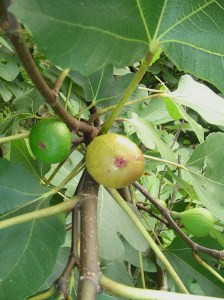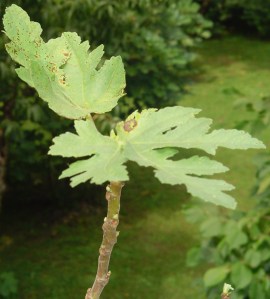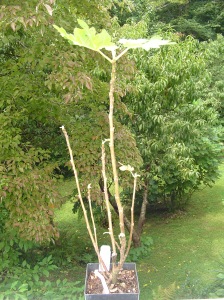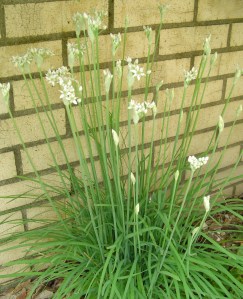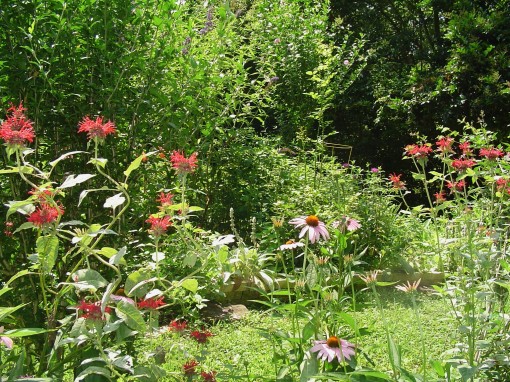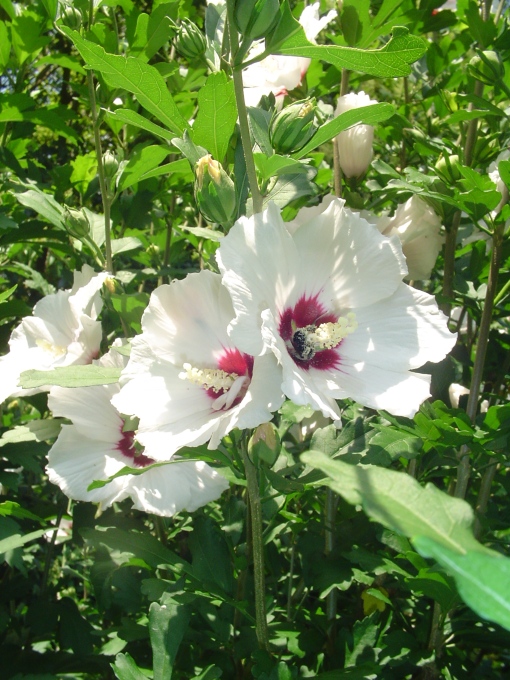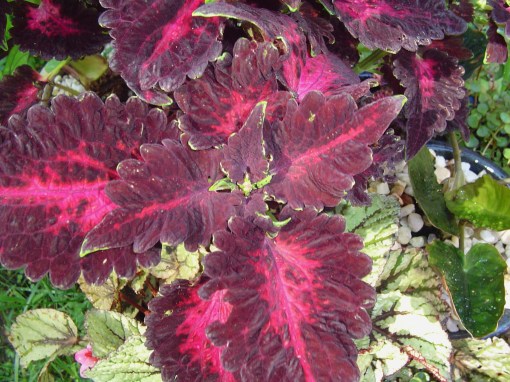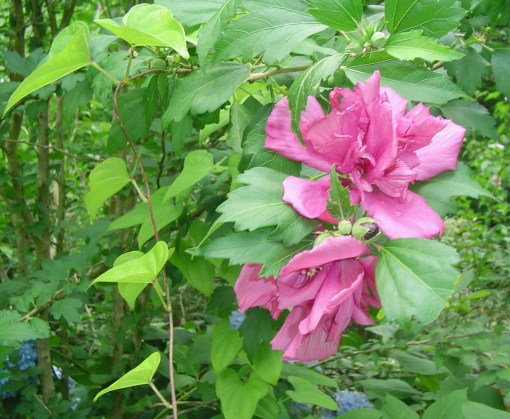 Figs are on my mind.
Figs are on my mind.
This is the time of year when our fig trees ripen their fruit.
Last summer our fig trees were loaded. A friend and I picked repeatedly, and had a steady supply of fruit for over a month.
(There is a recipe for Fig Pickles at the end of the post.)
This year I’ve picked here and there since July, but haven’t gotten more than a handful at a time.
 Today I got lucky.
Today I got lucky.
The variety growing here when we moved in stays green right up until the moment of ripeness, when the fruit swells and turns a yellowish green.
 The inside is pink to red, depending on ripeness. This isn’t a super sweet fig, but is delicious broiled with a little shaving of salty cheese on top. I favor a Tuscano cheese, but anything in the Parmesan family of cheeses is delicious.
The inside is pink to red, depending on ripeness. This isn’t a super sweet fig, but is delicious broiled with a little shaving of salty cheese on top. I favor a Tuscano cheese, but anything in the Parmesan family of cheeses is delicious.
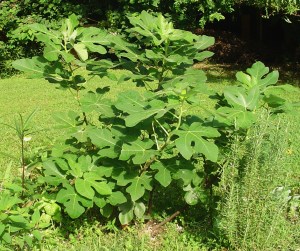
This fig came home in a 1 gallon pot last summer. Its figs are brown. It started the season with small green figs, but lost them along the way.
I’ve read that figs which stay green when ripe have an added protection from hungry animals who might take them as they ripen. Birds only peck at the figs I’ve left on the bush way too long so they split open. BUT, the deer have been molesting the fig trees this year, grazing leaves and ripping stems and branches.
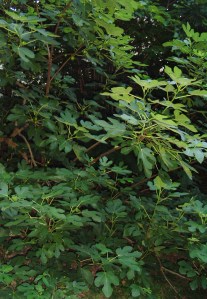
This fig tree grew so much in spring that its branches toppled over, changing the shape of the entire plant. New branches have sprouted along the now horizontal fallen branches. It grew quickly with the abundant rain, and was knocked over by the windstorms in June.
I gave pieces of one of these broken branches to some gardening friends, who rooted them successfully, and now have small trees.

The tall, heavy branches, fallen over in early summer, are sprouting new vertical growth. This beautiful tree just keeps getting bigger and bigger.
Visiting a fig loving friend yesterday evening, I commented on her ripe figs. We looked more closely. Her small bush, covered in ripening figs only days ago, had only two little figs still attached. We found the gaps where squirrels had gotten in through her netting.

A well protected fig in my friends garden, still was robbed by a squirrel who found an opening in the netting.
We both feel that our gardening efforts this year are chiefly for the benefit of hungry squirrels and deer. What a disappointment after an entire season of protecting and nurturing her new fig, planted only last fall, to find the fruit stolen. I’ve begun to wonder whether netting simply draws the squirrels attention, and signals something really good must be kept inside the enclosure…
We have just received two new “SIlver Lyre” fig trees from Plant Delights. This is a newly offered variety of Afghan Fig. I like the beautiful, lacy silver-toned leaves. These are advertised to grow quickly to a 20′ shrub, and I plan to plant them in the newly sunny area of our forest where the oak trees fell this spring.
They will quickly provide a bit of privacy from the street, but will never grow tall enough to create a hazard. In fact, they are supposed to be very sturdy in wind. I hope to one day harvest a few figs from them… If I can manage to keep the squirrels away.
Rick Austin, in his book, Secret Garden of Survival, describes a method of planting a “guild” of plants around a new fruit tree. Some of the plants bring up nutrients from the soil, some are good companion plants for the tree, and some plants protect the newly planted tree from critters. Not brave enough to plant an apple or persimmon, which I KNOW our squirrels would strip, I plan to try his method when planting these figs later in the fall.
I’ll surround the new figs with daffodil bulbs to create a wall of poisonous bulbs and roots against the voles, garlic or garlic chives to slow down the deer, and perhaps some Comfrey to enrich the soil and create that extra wall of distraction for the deer. They never touch my Comfrey or garlic chives, both of which attract bees and butterflies.
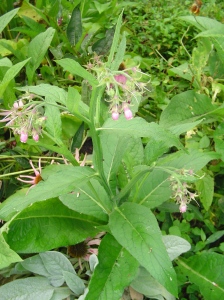
Comfrey, a perennial herb with tremendous healing properties, is an excellent herb for improving the soil. Its long tap root brings up nutrients from deep in the Earth. Its leaves are an excellent addition to compost to build fertility.
These little trees will go into pots tomorrow to let them grow a bit beefier before I plant them out in the garden, after the first frost, probably in December. The growers at Plant Delights had tremendous growth in their first year with “Silver Lyre”, and I will hope for the same results so these new trees fill out quickly. They will grow quite wide, as figs do, so the guilds will extend several feet out from their trunks. This will be an interesting process to watch unfold in the forest garden.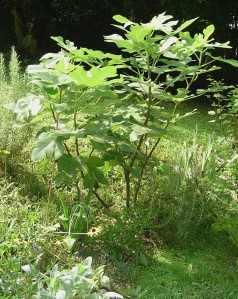
All photos by Woodland Gnome
Here is my favorite “Pickled Fig” recipe developed last autumn. I made several batches, tweaking the recipe each time. I’m hoping there is a large enough harvest to make them again in a few weeks!
Pickled Figs
6 c. sugar
1 cup boiling water
¾ c. white Sangria
½ c. red wine vinegar
1 TB ground cinnamon
1 TB ground allspice
1 Tsp. ground cloves
4 medium lemons, washed
6-8 chili peppers, green or red
20-30 ripe figs
(Boil a kettle of water for preparing the figs. Have on hand about 3/4 c. of baking soda to sprinkle on the figs before they are cooked.)
1. Measure the sugar into a dutch oven, add 1 c. of water, and turn on medium heat.
2. Wash and trim the figs. Place in a large ceramic bowl. Sprinkle them with baking soda, and cover with boiling water. Allow to soak for 10-12 minutes.
3. Wash and thinly slice the lemons. Halve or quarter the slices, catching the juice. Julienne the end pieces, which are mostly peel. Add fruit and juice to the sugar mixture, along with the spices, Sangria, vinegar, and washed peppers.
4. Rinse the figs in cool water, peel off any discolored skin, and slice the figs in halves or quarters as they are added to the sugar, lemon, and spice mix.
5. Simmer, stirring occasionally, for 30 minutes; allowing the syrup to thicken and the lemons to become translucent.
6. Allow the mixture to sit, covered, for 12 to 24 hours.
7. Reheat to boiling and can in glass jars.
More information on figs:
http://www.treesofjoy.com/fig-varieties-collection
http://www.spadespatula.com/2012/04/10/fig-varieties-common-fig-sounds-boring-but-isnt/
http://www.foodrepublic.com/2012/08/27/6-types-figs-try-right-now
